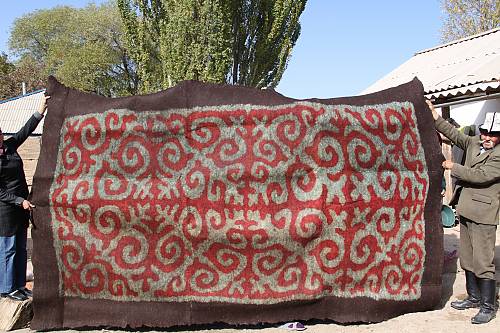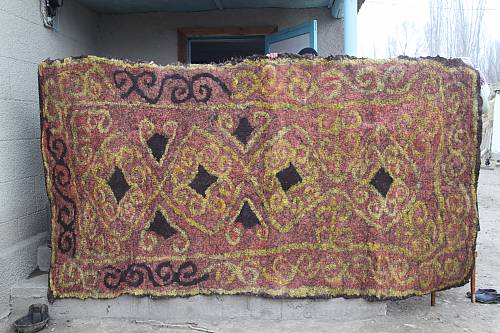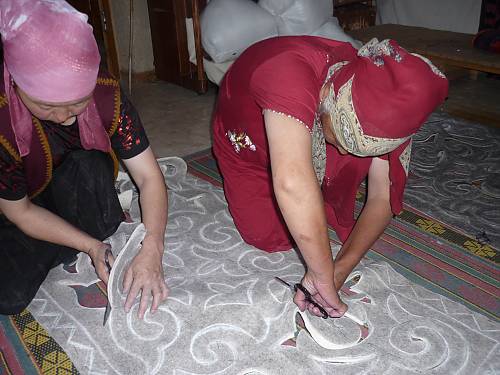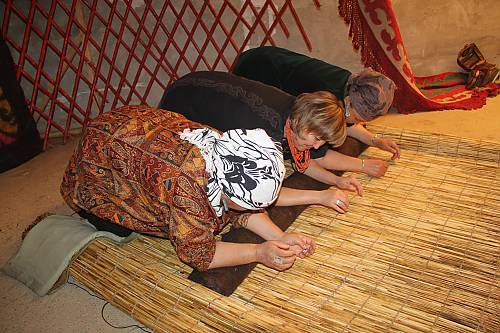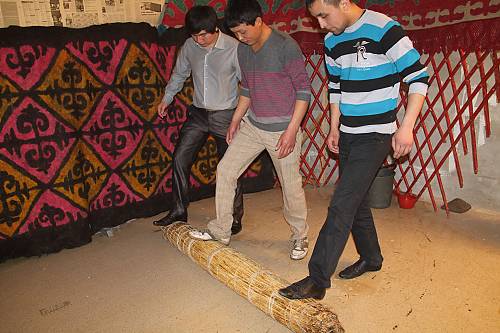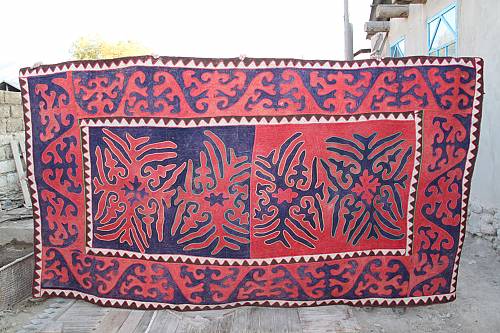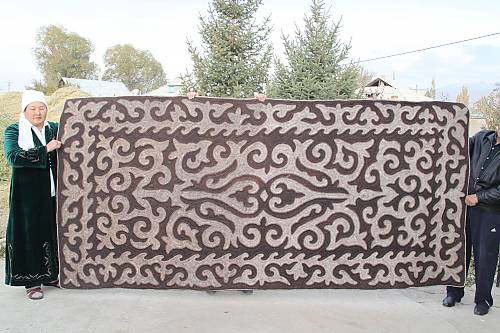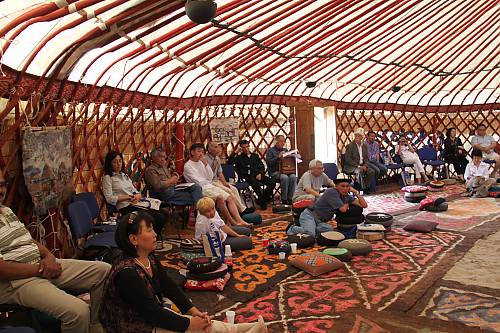Report on the status of an element inscribed on the list of intangible cultural heritage in need of urgent safeguarding
A. Cover sheet
A.1.
State Party
Name of State Party
Kyrgyzstan
A.2.
Date of deposit of the instrument of ratification, acceptance, approval or accession
This information is available online.
Date of deposit of the instrument of ratification, acceptance, approval or accession
2006-11-06
A.3.
Element inscribed on the Urgent Safeguarding List that is the subject of this report
Name of element
Ala-kiyiz and Shyrdak, art of Kyrgyz traditional felt carpets
Inscribed in
2012
Submitting State(s)
Kyrgyzstan
A.4.
Reporting period covered by this report
Please indicate the period covered by this report.
Reporting period covered by this report
15-12-2017 - 15-12-2025
A.5.
Other elements inscribed on the Urgent Safeguarding List, if any
Please list all other elements from your country inscribed on the Urgent Safeguarding List, together with the year of inscription; for multinational elements, please indicate the other States concerned.
A.6.
Executive summary of the report
Please provide an executive summary of the report that will allow general readers to understand the current status of the element, any positive or negative impacts of inscription, the implementation of safeguarding measures during the reporting period and their possible update for the following years.
Executive summary of the report
During the reporting period (2018–2025), the safeguarding of Shyrdak and Ala-kiyiz – the traditional Kyrgyz art of felt carpet-making – progressed from stabilizing a fragile practice to consolidating a dynamic, self-sustaining form of living heritage. Since their inscription on UNESCO’s List of Intangible Cultural Heritage in Need of Urgent Safeguarding in 2012, both practices have evolved from primarily household production into widely valued expressions of cultural identity, women’s creativity, and community well-being across the country.
Today, felt carpets are among the most esteemed handmade products in Kyrgyzstan and increasingly visible internationally. Their production continues to rely on local wool, natural dyes, and manual techniques that preserve environmental knowledge and maintain the cultural symbolism of traditional motifs associated with harmony, prosperity, and protection. For many rural women, felt-making has become a stable and dignified source of income. A national mapping and digital documentation project (2024-2025) identified 1,791 artisans, including 685 Shyrdak and 75 Ala-kiyiz makers, whose average age is now about ten years younger than at the time of inscription – clear evidence of generational renewal. (See Table 1).
Safeguarding measures implemented between 2018 and 2025 were highly effective. Transmission was strengthened through over 600 apprenticeships, regional workshops, museum programmes, and newly developed teaching materials documenting 55 traditional Shyrdak patterns. Annual “Kyrgyz Shyrdagy” and “Oimo” festivals became major national platforms, attracting hundreds of artisans each year and contributing more than twenty exemplary carpets to museum collections. Media features, documentaries, and digital content expanded public recognition, while tourism-based master classes connected safeguarding with sustainable rural livelihoods.
Market development advanced considerably as cooperatives improved their production management, export partnerships expanded, and training in design, natural dyes, marketing, and e-commerce increased artisans’ economic resilience. Institutional reforms, including the Law on Crafts (2022), Law on Creative Industries (2022), and Presidential decrees establishing the National Programme for the Preservation and Development of National Traditions (2022-2027), created a stronger policy environment. In 2019, the World Crafts Council designated Naryn Province as the “World Craft City for Felt Carpet” reinforcing both national pride and international visibility.
A bilateral Official Development Assistance (ODA) project “Promoting Cultural Tourism Industry by Capacity Building for Production and Digital Marketing of Traditional Craft in the Kyrgyz Republic” (2023-2026), implemented by the Korea Heritage Service and ICHCAP with the Ministry of Culture and the National Commission for UNESCO, reinforces training, policy frameworks, and digital marketing while creating regional craft centres that benefit women and youth.
No negative impacts of inscription have been reported. Instead, inscription has increased national visibility, strengthened women’s leadership in cultural industries, expanded interregional cooperation, and reinforced community pride. Transmission systems remain strong, market demand is steady, and safeguarding actions are now embedded in both community practice and national policy.
Given the significant progress achieved and the strengthened institutional foundations, Shyrdak and Ala-kiyiz have evolved into resilient, widely practiced traditions fully aligned with sustainable development and cultural-tourism priorities. The element is increasingly well positioned for future consideration for transfer from the List of ICH in Need of Urgent Safeguarding to the Representative List of the Intangible Cultural Heritage of Humanity or the Register of Good Safeguarding Practices. Therefore, a working group was established to discuss the transfer of the element and prepare related forms
A.7.
Contact person for correspondence
Provide the name, address and other contact information of the person responsible for correspondence concerning the report.
Title (Ms/Mr, etc.)
Ms
Family name
Soltongeldieva
Given name
Sabira
Institution/position
Secretary-General, National Commission of the Kyrgyz Republic for UNESCO
Address
720040, Erkindik Blvd. 54, Bishkek, Kyrgyz Republic
Telephone number
+996312626761
E-mail address
natcomunesco.kg@gmail.com
Other relevant information
B
Ms
B. Status of element inscribed on the Urgent Safeguarding List
Refer to the nomination file or to previous reports, if any, as the basis for reporting on the current status of the element, and report only on relevant changes since the date of inscription on the List or since the previous report. Nomination files, specific timetables and earlier reports, if any, are available at https://ich.unesco.org or from the Secretariat, upon request.
The State Party shall pay special attention to the role of gender and shall endeavour to ensure the widest possible participation of the communities, groups and, where applicable, individuals concerned as well as relevant non-governmental organizations during the process of preparing this report, and is asked to describe how it has done so in point D below.
B.1.
Social and cultural functions
Please explain the social and cultural functions and meanings of the element today, within and for its community, the characteristics of the bearers and practitioners, and any specific roles or categories of persons with special responsibilities towards the element, among others. Attention should be given to any relevant changes related to inscription criterion U.1 (‘the element constitutes intangible cultural heritage as defined in Article 2 of the Convention’).
Social and cultural functions
Shyrdak and Ala-kiyiz continue to hold an essential social and cultural role in contemporary Kyrgyz society. Rooted in nomadic history yet actively practiced today, they provide communities with a strong sense of identity, continuity, and belonging. The making of felt carpets brings together families, neighbours, and community groups in shared creative work, reinforcing cooperation, mutual support, and intergenerational dialogue.
The practice remains fundamentally collective. Women are the principal bearers and transmitters of knowledge, responsible for designing patterns, selecting colours, felting, stitching, and teaching. Learning occurs informally within families, most often between mothers, grandmothers, and daughters, and within women’s cooperatives that have become central hubs of transmission. These settings convey not only technical skills but also cultural values such as patience, mutual respect, and social responsibility.
Men contribute to complementary stages like sheep shearing, wool preparation, heating water, felt pressing, and occasionally marketing and transportation. Thus, helping maintain an inclusive production system in which different generations and genders participate. In many communities, work is initiated or concluded with blessings or good wishes from elders, reaffirming the spiritual and social significance of the practice.
The ornaments and motifs applied to Shyrdak and Ala-kiyiz express ideas of harmony, prosperity, and protection through stylized representations of horns, wings, spirals, and ecological forms. These visual languages link people to their environment and to collective memory, functioning as narratives of identity and shared heritage. Felt carpets continue to be widely used in domestic, official and ceremonial contexts, including weddings and gift exchanges, echoing the enduring notion that “Kyrgyz are born and die wrapped in felt.”
Today, felt carpets also carry economic and social value, especially for rural women. The growth of community cooperatives, tourism workshops, social enterprises, and national festivals has strengthened the craft’s relevance as a source of livelihood. This integration of creativity and income-generation reinforces pride in local heritage and increases youth interest in learning traditional techniques.
A range of actors supports the practice: family workshops and cooperatives safeguard knowledge; national craft associations maintain design standards and facilitate markets; NGOs and museums contribute to documentation, teaching, and community outreach; and government bodies provide policy support and funding. Designers and ornament specialists hold particular responsibility for maintaining stylistic diversity and ensuring that motifs retain cultural meaning even as new forms and markets develop.
In contemporary Kyrgyzstan, Shyrdak and Ala-kiyiz therefore function as living expressions of creativity, community cohesion, and sustainable livelihood, embodying a dynamic relationship between people, their environment, and their heritage. Their continued practice demonstrates a strong and evolving system of social and cultural functions.
B.2.
Assessment of its viability and current risks
Please describe the current level of viability of the element, particularly the frequency and extent of its practice, the strength of traditional modes of transmission, the demographics of practitioners and audiences and its sustainability. Please also identify and describe the threats, if any, to the element's continued transmission and enactment and describe the severity and immediacy of such threats, giving particular attention to any strengthening or weakening of the element’s viability subsequent to inscription.
Assessment of its viability and current risks
The current viability of Shyrdak and Ala-kiyiz is strong and has improved significantly since their 2012 inscription. Both practices are widely transmitted, regularly enacted, and closely integrated into cultural, social, and economic life across Kyrgyzstan, though with different dynamics for each component.
Shyrdak has developed into a highly visible and firmly established practice. It is produced year-round in six provinces and supported by hundreds of women artisans working in family workshops, community cooperatives, and professional enterprises. Its use in household decoration, wedding dowries, ceremonial exchanges, and public cultural events ensures continued relevance. Especially shyrdak is highly valued these days, being presented at high-level governmental events. Demand remains stable and growing, supported by local buyers, tourists, and expanding export markets. Cooperatives such as “Urmat” and “Nakhta,” as well as professional craft enterprises, contribute to consistent quality, reliable orders, and broader outreach, while annual festivals provide nationwide platforms for visibility and exchange.
Ala-kiyiz, though used less frequently in its traditional domestic form, remains viable through functional and artistic adaptation. Its flexible felting technique is increasingly used in contemporary wall panels, garments, accessories, and design projects, allowing artisans, designers, and students to maintain technical knowledge while exploring new applications (see Table 2).
This diversification has become essential for sustaining its creative potential and economic relevance.
A clear sign of strengthened viability is the generational renewal of practitioners: most active artisans today are between 35 and 50 years old – approximately ten years younger than at the time of inscription. Transmission continues primarily through intergenerational family learning and women’s cooperatives, where shared production reinforces both technique and cultural values. Community-based tourism, workshops, and social enterprises further support transmission by engaging youth and linking learning with income-generation.
Felt-making transmission is supported through both formal and informal education. The element is integrated into school, vocational and higher-education curricula, complemented by extracurricular clubs and specialized courses. Informal education is dynamic, with NGOs, master-artisans and community networks organizing workshops, demonstrations and seminars that ensure hands-on transmission. Ongoing efforts by public institutions and communities aim to further strengthen educational integration and expand support mechanisms, contributing to the element’s sustainable safeguarding.
External support remains important. Programmes by NGOs and private craft enterprises help strengthen product development and marketing, while international partners, including UNESCO, UNDP, USAID, JICA, and ICHCAP, provide training, documentation, and market-support tools. The Kyrgyz-Korean ODA project (2023-2026) enhances viability by improving legal frameworks, building marketing and design capacity, establishing a national crafts database, supporting youth residencies, and creating three regional craft centers that connect artisans, cultural tourism, and creative industries.
Overall, Shyrdak demonstrates high resilience, while Ala-kiyiz maintains moderate but stable viability through innovation and cross-sector collaboration. Public recognition, youth engagement, and diversified markets have expanded notably since inscription. Transmission is strong in practice and spirit, and remaining risks can be mitigated through the planned national craft strategy and long-term institutional measures.
B.3.
Implementation of safeguarding measures
Please report on the safeguarding measures described in the nomination file, and previous report, if any. Describe how they have been implemented and how they have substantially contributed to the safeguarding of the element during the reporting period, taking note of external or internal constraints such as limited resources. Include, in particular, information on the measures taken to ensure the viability of the element by enabling the community to continue to practise and transmit it. Include the following detailed information concerning the implementation of the set of safeguarding measures or safeguarding plan:
B.3.a.
Objectives and results
Indicate what primary objective(s) were addressed and what concrete results were attained during the reporting period.
Objectives and results
Between 2018 and 2025, the safeguarding of Shyrdak and Ala-kiyiz focused on consolidating the viability of both practices and strengthening the conditions for their continued transmission. The overarching objective was to support the transition of the element from requiring urgent safeguarding toward becoming a stable and representative expression of Kyrgyz living heritage. This was pursued through four interconnected goals: enhancing intergenerational transmission, raising awareness, improving livelihoods, and reinforcing institutional frameworks.
Strengthening transmission and education yielded significant results. More than 1020 young women completed practical apprenticeships under master craftswomen, while additional learners participated in regional workshops, museum-led programmes, and elective vocational courses. The documentation of 55 traditional Shyrdak patterns and the development of illustrated teaching manuals facilitated more structured and consistent instruction across producing regions. As a result, the average age of practitioners has shifted downward by roughly a decade, confirming renewed youth engagement.
Raising awareness and visibility achieved wide reach. The annual “Kyrgyz Shyrdagy”, “Ala-Kiyiz Fest” and “Oimo” festivals grew into major national events drawing several hundred artisans and thousands of visitors each year. These platforms strengthened interregional exchange, public understanding, and cultural pride. More than twenty exemplary carpets were incorporated into national museum collections, while extensive media and digital storytelling expanded the audience beyond festival grounds and reinforced the recognition of felt-making as a key component of Kyrgyz cultural identity. Both carpets have been presented at international exhibitions dedicated to crafts as key artworks e.g. Cheongju Craft Biennale 2025 held in Korea.
Improving livelihoods and market development resulted in increased economic resilience. Cooperatives strengthened their production capacity and marketing skills, while the provision of over 1,000 m² of workshop and retail space improved working conditions and access to domestic markets. Stable and expanding demand both in Kyrgyzstan and abroad, enabled reliable income generation for rural women. Export-oriented cooperatives achieved annual earnings exceeding USD 45,000, and the average price of Shyrdak rose from USD 22/m² in 2012 to approximately USD 70/m² by 2022. Ala-kiyiz, though less widely practiced, maintained relevance through diversification into contemporary design, accessories, and interior décor.
Reinforcing institutional and legal frameworks created a more secure enabling environment. Adoption of the Law on Crafts (2022), the Law on Creative Industries (2022), and national policy instruments on creative economy and traditional heritage strengthened institutional recognition and coordination mechanisms. In 2019, Naryn Province received the designation of “World Craft City for Felt Carpet,” contributing to international cooperation and regional identity.
Overall, the implementation of the safeguarding plan substantially improved the viability of Shyrdak, which now demonstrates strong resilience, while Ala-kiyiz maintains stable practice through ongoing innovation and adaptation. Together, these results indicate sustained progress toward long-term safeguarding.
B.3.b.
Safeguarding activities
List the key activities that were carried out during this reporting period in order to achieve these expected results. Please describe the activities in detail and note their effectiveness or any problems encountered in implementing them.
Safeguarding activities
Safeguarding activities implemented between 2018 and 2025 built directly upon the objectives and results outlined above, translating them into sustained community-led action supported by national institutions and international partners. These activities strengthened transmission, enhanced visibility, expanded economic opportunities, and consolidated the policy environment, collectively contributing to the improved viability of Shyrdak and Ala-kiyiz.
Transmission and education activities are carried out through diverse pathways, combining both formal and informal approaches to ensure continuity of the element. Felt-making is integrated into the curricula of primary, secondary and vocational schools, as well as extracurricular activities and clubs. These classes are enriched by the participation of craftspeople, who engage with students through presentations and hands-on practice.
Another important aspect of transmission is the strengthening of traditional apprenticeship while expanding access to structured learning. Master craftswomen in producing regions conducted multi-month apprenticeships that trained young women in wool processing, felting, stitching, and ornament application. Village cooperatives facilitated these cycles, typically involving 5–15 learners, ensuring continuity within family and community settings. Between 2018 and 2025, regional workshops held in Naryn, Issyk-Kul, Osh, Talas, and Chui introduced UNESCO 2003 Convention, intensive technique-based training and design sessions.
Museums contributed through public education programmes; notably, the Frunze Museum hosted a UNESCO-supported heritage school in 2019 combining hands-on learning with lectures and study of historical Shyrdak examples, while the Fine Arts museum supported UNESCO-led special exhibition and the movie screening for Ala-Kiyiz in 2024 to raise the awareness of public general.
During the COVID-19 period, artisans and cooperatives adapted by producing video tutorials, livestreamed demonstrations, and step-by-step digital teaching materials. These became valuable tools for youth and urban learners and remain in use today. Illustrated teaching manuals and the documentation of traditional patterns supported the standardization of basic learning materials.
Awareness-raising and visibility initiatives were anchored in the annual “Kyrgyz Shyrdagy”, “Ala-Kiyiz Fest” and “Oimo” festivals, which served as the main national platforms for showcasing craftsmanship, fostering exchange, and presenting new works. Each festival brought together several hundred artisans and involved competitions, design laboratories, live demonstrations, and themed exhibitions. Community volunteers, local cultural departments, and cooperatives jointly organized these events, ensuring cost-effective implementation. Regional cultural centres supported year-round engagement through pre-festival training sessions and community exhibitions.
Mass media and digital outreach expanded the impact of festivals and everyday practice. Television and radio features profiled artisans and explained the cultural significance of ornament systems, while documentaries and online storytelling increased public engagement. Artisans and cooperatives regularly produced social media videos demonstrating techniques or sharing family histories, reaching domestic and international audiences. Museum acquisitions of newly produced carpets further strengthened visibility and provided institutional recognition. Documentaries and PR videos created with close cooperation and consultation with craftspeople.
Market development and livelihood support were advanced through training, cooperative strengthening, and improved access to production and retail spaces. Entrepreneurship workshops covered cost calculation, quality standards, branding, and online sales skills. Natural dye workshops offered environmentally sustainable colouring methods. Cooperatives benefited from guidance on internal governance, bulk procurement of wool, and collective marketing strategies.
Production and retail premises provided through craft associations expanded artisans’ ability to work collectively and sell directly to consumers. Several cooperatives developed export pathways through participation in curated exhibitions and trade fairs. Professional craft enterprises contributed to value-chain consolidation by offering design mentoring, product review, and guaranteed purchase orders, which enabled rural artisans to access broader markets. Integration with community-based tourism created additional income opportunities and enhanced visitor engagement. Although Shyrdak benefitted most from these developments, Ala-kiyiz required continual support in promotion.
Institutional, policy, and international cooperation activities reinforced the enabling environment for safeguarding. Following the adoption of national laws and policy instruments, awareness sessions were conducted to present the ICH Convention, explain national registration procedures and legal provisions to artisans and cooperatives. Coordination with regional authorities strengthened support for festivals, exhibitions, and training initiatives.
International cooperation expanded substantially from 2023 onward with the launch of the Kyrgyz-Korean ODA Project. The project established regional Craft Centers equipped for training, exhibitions, and design development; delivered capacity-building on digital marketing and product innovation; facilitated participation in the Cheongju Craft Biennale; and supported policy-development workshops and the piloting of a national artisan database. These efforts significantly enhanced national capacity and strengthened the integration of felt-making into cultural tourism and the creative economy.
Overall, activities carried out during this period were effective in addressing the safeguarding objectives. Transmission diversified and strengthened; public awareness expanded; livelihoods improved; and policy foundations were reinforced. Remaining challenges include the more limited visibility and viability of Ala-kiyiz and the need for systematically integrated craft education. Nonetheless, the combined efforts of communities, institutions, and partners have positioned Shyrdak and Ala-kiyiz as resilient and dynamic components of Kyrgyz cultural heritage.
B.3.c.
Participation of communities, groups or individuals in the safeguarding activities
Describe how communities, groups or, if appropriate, individuals as well as relevant non-governmental organizations have effectively participated, including in terms of gender roles, in the safeguarding measures. Describe the role of the implementing organization or body (name, background, etc.) and the human resources that were available for implementing safeguarding activities.
Participation of communities, groups or individuals in the safeguarding activities
The safeguarding of Shyrdak and Ala-kiyiz during 2018-2025 remained deeply rooted in the participation and leadership of communities. Because felt-making is inherently collective, intergenerational, and gender-inclusive, all safeguarding measures were implemented through structures that reflect the internal organization of the craft tradition itself.
Across producing regions, community craft groups and village cooperatives served as the primary drivers of safeguarding. Usually composed of 10-30 members, these groups bring together elder masters, experienced practitioners, and younger learners. Elder women lead training, transmit pattern knowledge, and set quality standards, while younger artisans contribute to product diversification, digital content creation, and marketing. Men continue to support wool shearing, pressing, heating water, transport, and tool production, ensuring that the wider household and community remain integrated into the process. This division of responsibilities helped maintain a balanced gender dynamic and a resilient intergenerational learning environment.
Women’s cooperatives and community-based enterprises emerged as important engines of safeguarding, as increased market relevance strengthened women’s roles in family income generation and community decision-making. Social enterprises and private craft companies collaborated with rural artisans on design mentoring, product development, and guaranteed purchase orders, reinforcing the link between safeguarding and sustainable livelihoods.
A network of national organizations further supported and coordinated community initiatives. The Crafts Council of Kyrgyzstan guided national-level actions, including festivals, training programmes, and advocacy. The “Shyrdakchy” and “Altyn Choichok” associations contributed to peer-to-peer mentoring, ornament research, and preservation of regional styles. The National Association “Kyyal” provided production and retail spaces that enabled cooperatives to work consistently throughout the year. NGOs including CACSARC-kg, Kiyiz Duino, and Felt Art Studio contributed research, documentation, community workshops, and media materials, strengthening both visibility and knowledge transfer.
The Ministry of Culture acted as the central coordinating body, providing partial funding for festivals, facilitating cooperation with regional administrations, and ensuring communication with UNESCO and the World Crafts Council. Museum specialists, teachers, and cultural workers played a key role by curating exhibitions, hosting workshops, and creating public education programmes in both urban and rural settings.
International partners like UNESCO, UNDP, USAID, JICA, ICHCAP, and others offered training, technical expertise, and support for entrepreneurship, digital marketing, and policy development. Their contributions enhanced community capacities while respecting community leadership.
Since 2023, communities, groups, individuals, NGOs, craft associations, researchers, and state institutions have been actively engaged in the planning, consulting and implementing the Kyrgyz-Korean ODA Project aimed at safeguarding and promoting traditional Kyrgyz crafts.
Most safeguarding activities relied on voluntary labour from artisans, community organizers, and local trainers, complemented by modest state and donor support. This strong sense of ownership, motivation, and cooperation has been central to the revitalization of Shyrdak and Ala-kiyiz. As a result, safeguarding has evolved into a shared, inclusive process, led by communities and reinforced by institutional and international partnerships, ensuring the element’s continued vitality as a dynamic form of living heritage.
B.3.d.
Timetable
Indicate in a timetable when each activity was implemented.
Timetable
The safeguarding measures implemented in 2018 -2025 followed a phased and cumulative timetable, reflecting the objectives and activities outlined in the safeguarding plan.
1.2018-2019 – Establishing institutional foundations and strengthening training frameworks
•Consultations held to develop the Law on Crafts, granting legal recognition to artisans and cooperatives and enabling their formal participation in safeguarding measures.
•Integration of the "Oimo" and "Kyrgyz Shyrdagy" festivals into the state cultural calendar, ensuring annual budget allocations and signaling state commitment to promoting felt-making.
•UNESCO-supported exhibition and three-day training at the M. Frunze Museum (2019), introducing structured instruction for artisans, students, and teachers and strengthening museum-led education.
•Documentation of 55 traditional Shyrdak patterns and publication of teaching manuals by Felt Art Studio, supporting systematic learning across regions.
•Designation of Naryn Province as "World Craft City for Felt Carpet " (2019) by the World Crafts Council, enhancing regional pride and international recognition.
2.2020-2021 - Expanding transmission and safeguarding networks
•Regular workshops and intergenerational apprenticeships implemented by cooperatives, museums, and community-based tourism networks across five provinces.
•Continuation of craft transmission during the COVID-19 pandemic through online tutorials and video-based teaching produced by artisans and cooperatives.
•Completion of the 2018-2021 safeguarding plan, resulting in strengthened transmission, increased visibility, and improved incomes for rural women.
3.2022-2023 - Policy consolidation and digital expansion
•Adoption of the Law on Crafts (2022), the Law on Creative Industries (2022) and the Presidential Decree on the National Programme for the Preservation and Development of National Traditions (2022-2027), embedding safeguarding within national development strategies.
•Entrepreneurship, design, and digital marketing trainings delivered through cooperation between the Crafts Council, USAID, UNDP, and regional partners.
•Launch of the Kyrgyz-Korean ODA Project (2023-2026), implemented by the Korea Heritage Service, ICHCAP, and the Ministry of Culture. The project initiated work on new craft centres, digital tools, and policy development.
4.2024-2025 - Nationwide documentation and strengthened community engagement
•National mapping and digital documentation initiative (Oct 2024-July 2025) recorded 1,791 artisans, including 685 Shyrdak and 75 Ala-kiyiz makers, confirming practitioner rejuvenation and countrywide practice.
•Annual festivals continued to gather several hundred artisans, enabling exchange, innovation, and museum acquisitions of exemplary carpets.
•Cooperatives deepened engagement with tourism, online markets, and social-enterprise collaborations, creating more stable income streams and encouraging youth participation.
5.2026 and beyond - Institutionalization and long-term sustainability
•Development of the State Programme for the Development of the Craft Sector (2026-2030) by the Ministry of Culture, with expected inclusion of Shyrdak and Ala-kiyiz within broader national craft strategies.
•Continued activities by the Ministry of Culture to further promote the element, enhance the database, establish the certification system and strengthen educational system
•Ongoing implementation of the ODA Project through 2026, including the expansion of craft centres, continued capacity-building trainings and youth residencies, and support for policy and certification systems.
Together, these measures form a coherent safeguarding trajectory that progressively strengthened transmission, visibility, market viability, and institutional support.
B.3.e.
Budget expenditures
Provide the detailed amounts of the funds used for the implementation of each activity (if possible, in US dollars), identifying the funding source for each (governmental sources, in-kind community inputs, etc.).
Budget
The safeguarding expenditures between 2018 and 2025 correspond directly to the activities and timeframes described in Sections B.3a-B.3d, reflecting a balanced combination of state funding, donor programmes, private-sector support, and substantial in-kind contributions from communities and cooperatives. Based on consolidated national and partner records, total estimated spending for the period is approximately USD 750,000.
1.2018-2019 – Establishing institutional and training foundations (≈ USD 80,000)
Activities in this period focused on building the policy base and preparing teaching resources. This investment laid the groundwork for structured learning and consistent national coordination. Funding included:
•USD 35,000 – national budget (legal implementation, coordination);
•USD 25,000 – UNESCO Participation Programme (documentation of 55 Shyrdak patterns, training);
•USD 20,000 – in-kind inputs from community groups and NGOs (workshop venues, facilitation, materials).
2.2020-2021 – Expanding transmission and public outreach (≈ USD 130,000)
Expenditures reflected the shift to multi-province workshops, festival integration into the cultural calendar, and digital learning during COVID-19. These resources ensured uninterrupted transmission and strengthened community visibility. Funding sources:
•USD 45,000 – national and local authorities (workshops, festival preparations);
•USD 50,000 – development partners (training, outreach, online content);
•USD 35,000 – community and private in-kind support (volunteer labour, wool, tools).
3.2022-2023 — Market and institutional reinforcement (≈ USD 220,000)
This period aligned with new national policies expanded training in entrepreneurship and e-commerce, and provided workspace for cooperatives. Funding strengthened value chains and supported participation in international showcases. Funding consisted of:
•USD 85,000 – government allocations (infrastructure, festivals, coordination);
•USD 75,000 – international partners (business skills, digital marketing, design innovation);
•USD 60,000 – private sector and community contributions (materials, cooperative management, travel for exhibitions).
4.2024-2025 – Consolidation and digital promotion (≈ USD 320,000)
This phase corresponds to mapping activities, festival continuation, and the acceleration of digital and creative-economy measures through the Kyrgyz-Korean ODA Project. These investments introduced digital platforms, established three regional craft centres, and expanded tourism linkages. Funding:
•USD 70,000 – national and municipal budgets (events, coordination, local infrastructure);
•USD 180,000 – Korean ODA and ICHCAP inputs (craft centres, digital tools, training, international exchanges);
•USD 70,000 – cooperative reinvestment and community in-kind support (production spaces, demonstrations, training).
Overall Funding Summary (2018-2025)
Source Estimated Total (USD) Share (%)
Government of Kyrgyz Republic 230,000 31%
International partners 305,000 41%
NGOs, private sector, and community in-kind contributions 215,000 28%
Total ≈ 750,000 100 %
Safeguarding measures were implemented efficiently through cost-sharing between the government, international partners, private actors, and communities. Compared with the USD 1.12 million budgeted for 2013-2017 (as recorded in the previous report 38902-EN_USL), the 2018-2025 period reflects a more targeted and digitally oriented approach, achieving strong results with moderate but well-coordinated resources.
B.3.f.
Overall effectiveness of the safeguarding activities
Provide an overall assessment of the effectiveness of the activities undertaken to achieve the expected results and of the efficiency of the use of funds for implementing the activities. Please indicate how the activities contributed to achieving the results and whether other activities could have contributed better to achieving the same results. Also indicate whether the same results could have been achieved with less funding, whether the human resources available were appropriate and whether communities, groups and individuals could have been better involved.
Overall effectiveness of the safeguarding activities
Between 2018 and 2025, safeguarding activities for Shyrdak and Ala-kiyiz proved highly effective in meeting the objectives set out in the 2018-2021 plan and continued through subsequent years. The element progressed from a practice once considered vulnerable to a stable and self-sustaining tradition supported by strong transmission systems, active market demand, and favourable policy frameworks. The effectiveness of safeguarding derives from the coherent interaction of community-based transmission, national coordination, targeted training, and efficient use of funds, as outlined in previous sections.
A key factor in overall success was the community-driven transmission model, which remained the backbone of safeguarding. Apprenticeships conducted by master craftswomen, cooperative-based learning, and intergenerational workshops ensured regular, hands-on knowledge transfer across five provinces. This approach required minimal external intervention and remained fully functional even during the COVID-19 pandemic, when artisans adapted by producing digital tutorials and maintaining crafting from home. As a result, more than 1020 young women received direct training, and the average age of practitioners decreased significantly – clear evidence of renewed youth involvement and strengthened continuity.
Awareness-raising and visibility measures also demonstrated strong impact. Annual festivals, particularly “Kyrgyz Shyrdagy”, “Ala-Kiyiz Fest” and “Oimo,” evolved into cost-efficient platforms that combined exhibitions, competitions, training sessions, and sales opportunities. Supported by modest state funding and substantial community contributions, they consistently attracted several hundred artisans, showcased more than 1,000 felt items annually, and provided national visibility. Media reporting, museum exhibitions, and digital storytelling expanded audiences and strengthened public appreciation, validating the activities and outputs described in B.3b and B.3d.
Economic and market-oriented activities significantly enhanced artisans’ livelihoods. Training in entrepreneurship, natural dyeing, design adaptation, and e-commerce enabled cooperatives to diversify their products and secure predictable income streams. Allocated production spaces, mentorship from professional craft enterprises, and trainings conducted by private sector strengthened value chains by improving product quality, marketing, and access to export opportunities. These outcomes confirmed that effective safeguarding must align cultural goals with economic sustainability.
Institutional and policy reforms reinforced these achievements as they provided a coherent long-term framework for safeguarding. Coordination between the Ministry of Culture, the National Commission for UNESCO, and civil-society partners enabled more systematic support and ensured that safeguarding activities aligned with national development priorities. The timeline described in B.3d shows that policy advances occurred at key moments when community momentum was already strong by maximizing their impact.
A strengthening factor was the Kyrgyz-Korean ODA Project (2023-2026), which substantially increased national capacity through training, international exchange, digital marketing development, and the establishment of three regional craft centres. Its policy-development component supported work on a national strategy for 2026-2030, helping to institutionalize safeguarding for the long term. These investments, reflected in B.3e, significantly expanded the scale and modernity of safeguarding tools without requiring disproportionately high financial resources.
Overall, funds were used efficiently. With approximately USD 750,000 invested over eight years, the programme relied heavily on cost-sharing, volunteer labour, and existing infrastructure. This allowed a wide range of activities to be implemented with moderate but well-coordinated resources. Human resources were sufficient and became increasingly professionalized through training and partnerships.
However, some gaps remain and Ala-kiyiz still requires targeted promotion. Nevertheless, strong community ownership, active cooperatives, and new policy mechanisms have been effectively contributing for its safeguarding efforts.
In conclusion, safeguarding activities met and exceeded expected results. Transmission practices strengthened, market demand expanded, and institutional support deepened.
C
Kenzhetaeva
C. Update of the safeguarding measures
C.1.
Updated safeguarding plan
Please provide an update of the safeguarding plan included in the nomination file or in the previous report. In particular provide detailed information as follows:
- a. What primary objective(s) will be addressed and what concrete results will be expected?
- b. What are the key activities to be carried out in order to achieve these expected results? Describe the activities in detail and in their best sequence, addressing their feasibility.
- c. How will the State(s) Party(ies) concerned support the implementation of the updated safeguarding plan?
Updated safeguarding plan
The updated safeguarding plan for Shyrdak and Ala-kiyiz builds directly on the results of 2018-2025 and reflects the gradual transition of the element from one requiring urgent safeguarding to a stable and representative practice of Kyrgyz living heritage. It aligns national efforts with the bilateral Kyrgyz-Korea ODA project, funded by the Republic of Korea via Korea Heritage Service and implemented by ICHCAP in cooperation with the Ministry of Culture and the National Commission of the Kyrgyz Republic for UNESCO.
The plan pursues four main objectives:
1.Improvement of the legal and policy framework for traditional crafts (TC);
2.Capacity-building for stakeholders in the TC sector;
3.Strengthening value chains and cultural tourism based on TC;
4.Creation and operation of Traditional Craft Centers (TCCs);
Expected results by the end of the planning period include:
1.An adopted strategic plan (2026-2030);
2.A functioning certification system for TC;
3.An operational crafts database;
4.Three working TCCs with pilot programmes;
5.New tourism products based on carpets and other TC;
6.Strengthened capacities of around 130 key stakeholders and at least 50 graduates with full capacity to train further at least 5 apprentices each in the future.
The ODA project structures activities in four components (legal framework; capacity-building; value-chain development; infrastructure and TCCs), implemented mainly between 2024 and 2026. Policy work and certification are developed in parallel with training and product-development activities, while the database is tested together with marketing content and new tourism products. Infrastructural work on the three TCCs (design, renovation, equipment, opening) is accompanied by the design of pilot programmes, which will include carpet exhibitions and master classes in Ala-kiyiz techniques.
In parallel, the Ministry of Culture is preparing a State Programme for the Development of the Craft Sector for 2026-2030, drafts being expected by the end of 2025. Cooperation on craft development will be maintained at the international level, based on the agreements and MOUs signed between the Ministry and other member states. At the national level, promotional activities will be continued through digital tools and strengthened integration into educational curricula with support of the Ministry of Education.
The Ministry of Culture leads implementation on the Kyrgyz side, ensures policy coordination, and works on the new State Programme and the longer-term strategic plan. The National Commission for UNESCO supports coordination with national, regional and international partners. Local administrations in Chui, Naryn, and Issyk-Kul provide logistical and infrastructural support for the TCCs. Community-based organizations, cooperatives, and NGOs remain responsible for local implementation.
C.2.
Timetable for future actitivies
Provide a timetable for the updated safeguarding plan (within a time-frame of approximately four years).
Timetable
The updated safeguarding plan is implemented within the timeframe of the bilateral ODA project (2023-2026) and the subsequent national strategic and programme frameworks (2026-2030 and 2026-2030). The timetable emphasizes a phased approach that connects policy, capacity-building, value-chain development, and infrastructure.
1.2022-2023 – Project launch and coordination
•Design of the ODA project and establishment of cooperation mechanisms between the Korea Heritage Service, ICHCAP, the Ministry of Culture, and the National Commission for UNESCO;
•Preparatory work for legal, training, database, and infrastructure components.
2.2024 – Start of implementation and groundwork for all four components
•Initiation of work on the strategic plan (2026-2030) for TC and preparatory steps for a certification system;
•Launch of capacity-building activities for civil servants, specialists, and communities in TC policy, marketing, and design;
•Beginning of work on the TC database and tourism products using traditional crafts, including carpets;
•Start of design and planning for three Traditional Craft Centers at the National Museum of Fine Arts (Bishkek), “AS” Gallery (Naryn), and the Nomadic Civilization Center (Issyk-Kul).
3.2025 – Intensified capacity-building, product development, and promotion
•Continuation of training programmes in marketing, design, and product development for stakeholders (approximately 60 beneficiaries, including decision-makers, traders, and artisans);
•Implementation of the "Creative Lab" programme, resulting in around 420 graduates and jointly/individually created craft works;
•Further development and testing of the TC database, new tourism products (such as "Shyrdak" seat-cushions), and multilingual promotional content (video materials, leaflets, card news, etc.);
•Participation of Kyrgyz carpets and TC in the Cheongju Craft Biennale 2025 and related exchanges;
•Progress in reconstruction and equipping of the three TCCs and preparation of pilot programmes (exhibitions, master classes).
4.2026 – Consolidation of systems and transition to national frameworks
•Finalization of the strategic plan (2026-2030), proposals for amendments to the 2022 law on Crafts, and introduction of the crafts certification system;
•Completion and testing of the database;
•Operationalization of the three TCCs with pilot activities supporting transmission and cultural tourism;
•Continuation of training and exchanges as the ODA project concludes and its results are handed over to national institutions.
5. 2026 and beyond
•Adoption and implementation of the State Programme for the Development of the Craft Sector (2026-2030), currently being prepared by the Ministry of Culture and expected to include Shyrdak and Ala-kiyiz;
•Use of the strategic plan, certification system, database, digital platform, and TCCs as long-term tools for safeguarding and for integrating felt-making into cultural tourism and the creative economy.
•Further strengthening safeguarding efforts between communities and various stakeholders including museums, NGOs and associations, educational institutions, etc. to ensure continued practice and transmission.
•Implementation of cooperative projects with the youth from Association of Creative Industries and the High Technology Park to integrate and further promote carpets and other crafts among the public general.
C.3.
Budget for future activities
Provide the estimates of the funds required for implementing the updated safeguarding plan (if possible, in US dollars), identifying any available resources (governmental sources, in-kind community inputs, etc.).
Budget
The updated safeguarding plan for Shyrdak and Ala-kiyiz focuses on ensuring the long-term sustainability of the element and completing its transition from urgent safeguarding to full representativity within Kyrgyz living heritage. The approach is based on partnership, shared responsibility, and the gradual integration of safeguarding into national policy and economic frameworks rather than on large-scale external funding.
The principal financial backbone continues to be the Kyrgyz-Korean ODA Project (2023-2026), which already provides significant investment in training, infrastructure, and digital development. Future activities will be financed through a balanced mix of governmental support, international cooperation, and community participation. The Government of the Kyrgyz Republic, through the Ministry of Culture will provide the institutional foundation, including policy coordination and maintenance of regional Craft Centers.
National and local non-governmental organizations such as the Crafts Council of Kyrgyzstan, “Shyrdakchy”, “Altyn Choichok”, CACSARC-kg, and others will contribute through community-based training, marketing initiatives, and festival organization. Their in-kind participation, combined with volunteer engagement and cost-sharing practices, ensures that safeguarding activities remain community-led and financially efficient.
Private businesses, tourism networks, and artisan cooperatives will continue to invest in value-chain development and marketing, helping to secure local livelihoods. International partners, including UNESCO and the World Crafts Council, will provide complementary technical assistance, and visibility support.
The emphasis in the coming years will shift from emergency safeguarding toward sustainability, focusing on:
•Institutional consolidation through national legislation, certification systems, and the adoption of a strategic plan for traditional crafts (2026-2030);
•Educational expansion through the enhanced inclusion of craft skills in vocational and higher education;
•Market resilience via digital promotion, innovation, and fair-trade practices;
•Cultural visibility through festivals, exhibitions, and cross-border cooperation.
The financial model thus rests on long-term cooperation rather than short-term funding. It relies on the community’s strong motivation, institutional capacity already in place, and the gradual assumption of full state and local ownership.
By sustaining this approach, Shyrdak and Ala-kiyiz will continue to thrive as living traditions that connect creativity, identity, and livelihood.
C.4.
Community participation
Please describe how communities, groups and individuals, as well as relevant non-governmental organizations have been involved, including in terms of gender roles, in updating the safeguarding plan, and how they will be involved in its implementation.
00116
Community participation
The updating of the safeguarding plan for Shyrdak and Ala-kiyiz was carried out through broad and inclusive community consultation. Artisans, cooperatives, and local associations from all producing regions actively contributed to defining priorities, identifying needs, and shaping future actions. Meetings and discussions were facilitated by the Crafts Council of Kyrgyzstan in cooperation with the Ministry of Culture and regional authorities, ensuring that community perspectives guided the process from the outset. Women artisans, who constitute the majority of practitioners, played a central role in consultations, emphasizing the importance of intergenerational teaching, fair access to markets, and recognition of their creative and economic contribution. Their leadership continues to shape both the design and implementation of activities.
Young artisans, designers, and students were engaged through consultations organized by the Ministry of Culture, ensuring that the updated plan reflects new perspectives and technological innovation.
NGOs and community-based groups remain responsible for implementing most field activities, while government institutions provide coordination, technical support, and partial funding, ensuring that local voices are connected to broader safeguarding networks.
The updated safeguarding plan thus reflects the same participatory spirit as the craft itself – collective, inclusive, and intergenerational. Through shared responsibility among women, men, youth, NGOs, and state institutions, the safeguarding of Shyrdak and Ala-kiyiz remains firmly grounded in community initiative, ensuring its continuity.
C.5.
Institutional context
Please report on the institutional context for the local management and safeguarding of the element inscribed on the Urgent Safeguarding List, including:
- a. the competent body(ies) involved in its management and/or safeguarding;
- b. the organization(s) of the community or group concerned with the element and its safeguarding.
2006-11-06
Institutional context
The institutional context for safeguarding Shyrdak and Ala-kiyiz combines governmental, non-governmental, and international bodies.
Competent governmental bodies:
•The Ministry of Culture, responsible for national safeguarding policy and coordination, including the preparation of the State Programme for the Development of the Craft Sector (2026-2030)
•The National Commission for UNESCO, supports coordination with UNESCO and other various partners;
•Museums operating as Craft Centers strengthen cooperation with craft communities and raise the awareness;
•The Ministry of Education supports crafts integration into educational curricula
•The Tourism Department under the Ministry of Economy responsible for cultural tourism development with crafts communities involvement;
•The State Enterprise “Kyyal” National Association of Folk Handicrafts under the Presidential Administration, provides production and sales premises and supports promotion of traditional crafts;
•The State Agency for Intellectual Property and Innovation (Kyrgyzpatent), contributes to the legal protection and branding of traditional designs.
Community and NGO organizations concerned with the element:
•The Crafts Council of Kyrgyzstan, CACSARC-kg (initiator of the original nomination), “Kiyiz Duyno”, “Shyrdakchy”, and “Altyn Choichok” associations, organize training, documentation, research, and festivals;
•Local cooperatives and community groups such as “Kyrgyz Uz” (Dostuk), “Altyn Kol” (Kochkor), “Tolgonai Ene” (Karakol), and others, maintain production, mentoring, and local safeguarding initiatives.
International partners within the ODA framework:
•The Korea Heritage Service and ICHCAP, which implement the 2023-2026 ODA project.
Together, these institutions provide a coherent structure that links community-based safeguarding with national policy and international cooperation, ensuring the continued transmission, visibility, and practice.
D
Kamila
D. Participation of communities in preparing this report
Describe the measures taken to ensure the widest possible participation of the communities, groups and, where applicable, individuals concerned as well as relevant non-governmental organizations during the process of preparing this report.
Participation of communities in preparing this report
The preparation of this periodic report followed the same community-driven approach that characterizes the safeguarding of Shyrdak and Ala-kiyiz. From the outset, the Ministry of Culture ensured broad participation by coordinating consultations with community groups, cooperatives, national craft associations, and relevant NGOs across all producing regions. This process guaranteed that the report reflects the lived experience, priorities, and expectations of the practitioners themselves.
Regional consultations were conducted in Naryn, Issyk-Kul, Osh, Talas, and Chui, facilitated by the Crafts Council of Kyrgyzstan in cooperation with local cultural departments. Artisans, cooperative leaders, pattern specialists, and teachers, including members of “Shyrdakchy,” “Altyn Choichok,” “Kyyal,” CACSARC-kg, and “Kiyiz Duyno”, contributed through group discussions, interviews, and feedback on safeguarding results, ongoing challenges, and post-2025 needs.
Women, who remain the primary bearers and transmitters of the craft, played a central role. Their perspectives shaped the report’s emphasis on intergenerational teaching, community-based learning spaces, and sustainable market access. Young artisans, designers, and students were engaged through digital surveys and workshops conducted by the Ministry of Culture and within the framework of the Kyrgyz-Korean ODA Project (2023–2026), ensuring that emerging voices and creative approaches were included.
NGOs contributed data from workshops, mapping initiatives, and training programmes. Museum educators and local experts provided information on exhibitions, educational events, and transmission activities. The Ministry of Culture and the National Commission for UNESCO reviewed and consolidated all inputs, ensuring accuracy and alignment with national safeguarding policy.
This wide and inclusive participation reaffirmed community ownership of safeguarding efforts and strengthened the shared vision for transitioning Shyrdak and Ala-kiyiz from urgent safeguarding toward sustained, representative living heritage.
E
Culture programme specialist
National Commission of the Kyrgyz Republic for UNESCO
E. Signature on behalf of the State Party
The report should be signed by an official empowered to do so on behalf of the State, and should include his or her name, title and the date of submission.
Name
Sabira Soltongeldieva
Title
Secretary-General, National Commission of the Kyrgyz Republic for UNESCO
Date
18-12-2025
Signature
signed
Upload signed version in PDF

